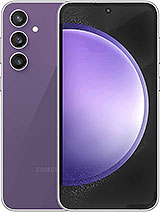Samsung Galaxy S23 FE review

Android 13 with One UI 5.1
The Snapdragon-based Galaxy S23 FE runs Android 13, augmented by Samsung's One UI, in its 5.1 incarnation. The One UI 6 with Android 14 is coming in a few weeks, too. Samsung promises "up to" 4 years of OS upgrades and 5 years of security patches.
The Galaxy S23 FE based on the Exynos chipset boots Android 14 with One UI 6 out of the box.

In any case, you'd be getting the same UI as higher-end Galaxy models, including DeX support.
You can choose between a few clock styles of the Always-on Display or opt for an Image Clock. Music info is also supported. The AoD can be always-off, always-on, scheduled, shown only when new notifications are available, or you can opt for tap-to-show for 10s.
The under-display fingerprint reader will likely be the primary method of unlocking for most, but you can still use face unlock either instead of or alongside it. It can be more convenient in certain situations, but it generally is less secure since it's just using the selfie camera. You can have the fingerprint icon displayed on the AoD or not, and you can have the reader itself always on or only available after you wake up the screen.





Biometrics • Fingerprint settings • Fingerprint enrollment • Face Recognition • Face Recognition
The experience when dealing with the basics is straightforward and familiar. The app drawer, notification shade, recent apps, lock screen and home screen, are all business as usual, as is the general Settings menu.
The accent color palette is automatically generated based on your wallpaper, and the system gives you a wide choice of color combinations and that palette can also be applied to app icons.






One UI 5.1 basics: Lockscreen • Homescreen • App drawer • Notifications • Quick settings • Task switcher
Widgets can now be stacked, and you can switch between stacked widgets with a simple swipe. Keep in mind that not all widgets support stacking, so app developers might have to get around that pretty soon.
Modes and routines, a feature similar to Apple's Focus, is present on the Galaxy, too. You can choose a mode based on what you are doing right now and execute certain actions, change sound profiles, display settings, notifications, etc. For instance, the driving Routines profile can be set up to turn on DnD mode and launch Spotify automatically, for example. You can even trigger certain Routines with actions of your choice, such as turning on the hotspot or airplane mode.
Familiar proprietary Samsung features include the Edge panels - the panes that show up when you swipe in from the side and provide tools and shortcuts to apps and contacts. Game launcher, the hub for all your games, also provides options for limiting distraction when gaming is here to stay as well. An in-house Gallery app and a proprietary file manager are both present, as well as Samsung's Internet web browser. Split-screen multitasking is also an option.






Edge panel • Game Launcher • Gallery • File manager • Split-screen • Pop-up window
Samsung also made connecting with nearby devices easier. In the Connected devices sub-menu, you will find available devices for Smart View connection (read screen cast) or Samsung DeX, where available. Chromecasts are easier to discover and stream audio too. When you play sound from your phone, nearby Chromecasts will appear on the quick panel.
And once you cast the phone's screen on a TV, for example, you can choose to hide your notifications so others won't be able to read sensitive information from your phone.
One UI 5.1 also introduces Continue browsing on PC - if you use Samsung's Internet mobile web browser, you can set up a hand-off of sorts to your PC's default web browser.





Continue Browsing on PC • Connectivity options • Link to Windows • DeX
Performance and benchmarks
Samsung's high-end phones were often subject to chipset fragmentation, the Galaxy S23 trio excluded. Well, the Galaxy S23 FE (as well as the upcoming Galaxy S24 flagships) brings back the said fragmentation, and different markets get different hardware platforms. The US version gets the Snapdragon 8 Gen 1 SoC (our model), while the global model elsewhere is based on the Exynos 2200 chip.
Samsung's Exynos 2200 chipset is from last year, and it is the heart of the Galaxy S22 series. It is a 4nm chip. The octa-core processor has a single powerful Cortex-X2 core, clocked at up to 2.8GHz, three Cortex-A710 units, working at up to 2.5GHz balancing performance and efficiency, and four Cortex-A510 at up to 1.8GHz little cores for power efficiency. Basically, it has the same general configuration as the Snapdragon 8 Gen 1 (our version), with the exception of the Cortex-X2 Prime core, which is clocked at 3.0GHz here.
The Exynos 2200 has this Xclipse 920 GPU, which is the result of a collaboration between Samsung and AMD and is based on the excellent RDNA2 architecture, as seen on computer GPU solutions. The Snapdragon model has the Adreno 730 GPU.
The Galaxy S23 FE has 8GB LPDDR5 RAM and is available in two storage versions - 128GB (ours) and 256GB.
This chipset is still quite relevant, so let's see its benchmark results.

The performance is similar on both smartphones with the exception of the GPU – the Snapdragon model has a consistent 5%-6% boost over the Exynos version.
Both processors are still quite competitive; on par with the recent Dimensity 8200 Ultra and Dimensity 9000 solutions, a little behind the 7+ Gen 2. The SD 8 Gen 2 is still the best, of course.
Both GPUs, on the other hand, are still across the best on the market, bested only by the SD 8 Gen 2 and on par with the recent Dimensity and previous SD 8 GPUs.
The AnTuTu scores are some of the best in this segment, too.
Both Galaxy S23 FE models are undeniably equipped very well, and they can handle everything you throw at them with flagship grace for the foreseeable future. And that's wonderful.
There is a BUT, though, about stability.
We ran the usual stress tests; the results are not peachy.The stability turned out to be average across both versions. The Snapdragon one offers 66% CPU and 46% GPU stability. The Exynos model scored 58% CPU stability and 50% for GPU
The CPU scored 66% stability on the 1-hour throttle test, which is an expected number for flagship chipsets.
The GPU stability, on the other hand, is utterly unimpressive at 46%. It can stay at peak performance for about 5 minutes, and then it's all downhill from there. And while this does not exactly represent real-life gaming, you can expect drops in performance once in a while in demanding games.



CPU test (Exynos) • GPU test (Exynos)



CPU test (Snapdragon) • GPU test (Snapdragon)
Both Galaxy S23 FE variants do become warm, but never that hot, which can be explained by the heavy throttling.
Overall, the Galaxy S23 FE has the guts to be a gaming machine, but since it has no adequate cooling, you will need to adjust both your expectations and your graphic settings.
Reader comments
- Faz
- 06 Apr 2025
- pKb
Absolutelt disaapointing product, much slower than my 6 year old iphone, Cant beleive samsung selling poor quality
- fay
- 11 Mar 2025
- LyW
After one year of being using this phone I have to say I hate the battery life. Imagine you're on vacation taking photos and videos, the battery won't make it half day without needing to be charged. Battery life is by far the most frus...
- Rajan Dobariya
- 23 Jan 2025
- rKS
Not bettery satisfied Poor bettery 3/10
























